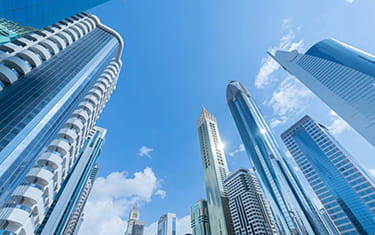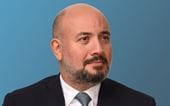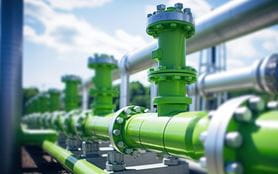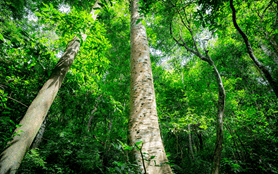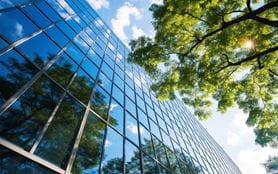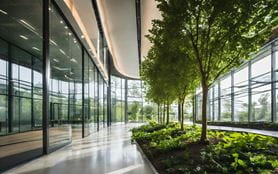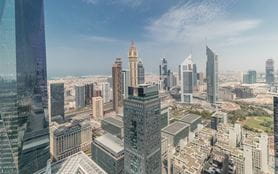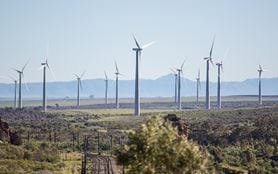Sustainable lending – a growing role for Islamic finance and Middle Eastern financiers
Related people
Headlines in this article
The last few years have seen a steady expansion of sustainable lending practices tied to achieving environmental, social and governance (ESG) goals as the world looks for new ways to meet the huge costs of decarbonisation and sustainable development.
Financing decisions are increasingly focused on matching up the interests of financiers and borrowers with sustainability goals, such as reducing carbon emissions, securing access to clean water and sanitation, promoting social inclusion and diversity, and improving the transparency of governance systems.
This trend is likely to accelerate as the world races to achieve Net Zero by 2050. Some predict that sustainable lending will become one of the biggest, if not the dominant, financing market in the near future.
Middle Eastern governments are increasingly aware of this market potential as they also pursue their own decarbonisation agendas and diversify their economies away from oil and gas dependence. Regional financial institutions also see the chance to develop a whole range of new financial products that not only address the ESG agenda but – in a market where Islamic Finance exerts considerable influence – can also complement the principles-based ethos that underpins the Shariah compliant Islamic Finance practice.
Responsible investment activity has been spurred on by various international climate conferences. The fact that COP27 was held in Egypt and that this year’s COP28 will be held in Dubai (the first time that successive COPs have been held in Middle Eastern countries) should give this trend further impetus.
The UAE was the first to join the “Race to Zero”, committing to Net Zero by 2050, and Saudi Arabia has set its sights on achieving that goal by 2060.
However, financing the transition to clean and low carbon technologies that are essential to achieving Net Zero remains a significant challenge, requiring huge investment.
ESG/Islamic Finance – identifying the synergies and differences
There are clear synergies between key ESG goals, such as achieving Net Zero, and the fundamental principles of Islamic Finance, including the aim of promoting environmental stewardship, social justice, and economic development.
Philosophically they are closely aligned, with an emphasis on long-term stable investment towards a goal of creating positive and sustainable environmental and social outcomes.
Shariah-compliant finance has, for instance, a prohibition against profiteering from lending, and extra charges on delayed payments often take the form of a donation to charities, often with ESG-related aims.
Beyond pure Shariah compliance, the Arabic word “Tayyib”, often translated as pure or wholesome, is increasingly being used in the context of Islamic Finance to align it with the principles of environmental stewardship and social justice.
Where Islamic Finance and ESG investing diverge is mostly around goal setting, with ESG seeking evidence that businesses have a positive purpose, rather than relying on excluding businesses which serve specific prohibited markets, such as the production of alcohol and tobacco, or arms manufacturing.
ESG investing also puts a stronger emphasis on engaging actively with businesses and promoting sustainability through ongoing engagement between the financier and the borrower.
Types of investment targeted by Middle Eastern financial institutions
Three types of ESG-related investment are attracting the attention of Middle Eastern financial institutions: transition financing, green and social financing, and sustainability linked financing.
Transition financing is aimed at businesses with a high carbon footprint that are eager to decarbonise in line with targets set out in the Paris Accord.
This type of investing is still nascent in the Middle East, partly because there is no clear consensus on the criteria for such financings, unlike in green and sustainability-linked deals. However, some examples exist, such as the USD600 million transition Sukuk (or Islamic bond) for Etihad Airways.
Green financing funds specific infrastructure projects with a clear environmental objective, for instance the construction of renewable energy facilities, green transportation, and investments in sustainable water and sanitation.
Where ESG investing is concerned, the Green Loan Principles that have been developed by the Loan Markets Association (LMA) set out conditions that need to be met for projects to be considered “green”. Financing documents, for instance, must:
- contain a purpose clause showing how funds will be deployed in a green project;
- identify how the project’s green credentials have been evaluated;
- explain how the funding will be disbursed and managed; and
- carry an obligation to report on the project’s environmental benefits and to update any certifications to make sure it remains green over time.
We are now seeing these kinds of frameworks being used by financiers in the region. For instance, the Dubai Islamic Bank is just one institution that has issued a Sustainable Finance Framework explaining how it will finance projects on principles similar to the Green Loan Principles.
Bahrain-based Infracorp issued its first green Sukuk to enable more sustainable infrastructure development across the Gulf, North Africa and South Asia, aligning with the market appeal for investments that have both a financial and an ESG impact. There have also been several real estate financings which have incorporated internationally recognised green building standards, such as Leadership in Energy and Environmental Design (LEED), which is encouraging for a region that is developing its infrastructure at an aggressive pace.
Social financing is similar to green financing but focuses on financing or refinancing activities with a clear social benefit, such as affordable housing, health and education, social inclusion, and humanitarian relief.
Sustainability-linked financing is the area in which we see the most scope for greater involvement by financial institutions and a real opportunity to advance decarbonisation, achieving Net Zero and other sustainability goals in the region.
Rather than being tied to a particular green project, the money invested via this route can be used for any purpose but the conditions of the financing are tied to sustainability related key performance indicators (KPIs) that the borrower must meet and that go beyond current regulatory targets, relating to, for instance, reducing carbon emissions.
Where a borrower fails to meet those KPIs, this would normally trigger a built-in variation in the financing terms, usually resulting in an increase in pricing.
To avoid a situation where a financier might profit from a failure to meet targets by receiving higher pricing, some financiers have pledged to donate any gains to ESG focused charities. As we discussed earlier, making donations in this way is very much in line with Islamic Finance principles.
Majid Al Futtaim’s USD1.2 billion sustainability linked financing is a key example of how corporates in the region are embracing ESG as a strategic priority.
This approach to financing the transition to Net Zero and other sustainability goals has obvious attractions, not least that it makes financing available to a wide range of businesses and can strongly influence how companies run their operations and the choices they are making around decarbonisation, offering a real incentive to making progress.
Initiatives already underway
There are clear signs that the shift towards sustainable financing is already underway in the region.
The green and sustainable bond and Sukuk market in GCC economies grew sharply in 2022, reaching USD28.5 billion, as banks and government-related entities increased their issuances. This was a significant jump from the USD605 million issued in 2021.
From a corporate finance perspective, Abu Dhabi Future Energy Company (Masdar) launched its syndicated revolving credit facility – the first “green” RCF in the Middle East.
At a project finance level, an interconnection project – which would allow countries in the region to exchange up to 3,000 MW of power has broken ground. This project included financing of a green loan from an international export credit agency and international banks.
Financings of this nature demonstrate that partnerships between international agencies, investors and financial institutions are vital in getting these critically important projects underway.
Overcoming challenges
Middle Eastern banks and financial institutions need to overcome several significant challenges in order to offer products with an ESG focus on a mass business and consumer level.
One challenge is transparency – there is no real history or culture of reporting on ESG matters in the region, partly due to the shortage of skills and expertise in this area.
However, as the focus on ESG intensifies in the region, particularly in light of COP28, we could see this changing quite dramatically. We expect that COP28 will foster public/private sector partnerships to improve the conditions for sustainable finance practices, which are vital for addressing the challenges of implanting effective ESG practices.
There are a range of internationally recognised standards and reporting frameworks that institutions in the region can lean on to address this challenge.
These include the Global Reporting Initiative and the Sustainability Accounting Standards Board. As banks become more familiar with the Green Loan Principles and the Sustainability Loan Principles published by the LMA, this will also provide a consistent and transparent framework for financiers, borrowers, sustainability coordinators and/or external reviewers to assess, monitor and report on the sustainability impact and benefits of their financings.
Another challenge is the region’s heavy dependence on oil and gas as a driver of the economy, despite the ambitious plans of several countries in the region to diversify their economies. As long as this dependence remains high, banks that are heavily reliant on oil and gas revenues will not face the same pressure to finance the transition as international banks with strong retail customer bases, unless there is a concerted effort at a regulatory level to implement ESG-related taxonomies.
The risk of greenwashing and the potential reputational damage and regulatory and even legal action that could also result from exaggerated claims of being “green”. As institutions move further into the ESG space, it is essential that financiers and borrowers exercise real care and caution over the green pronouncements they make, ensuring they are factually accurate and, where possible, verifiable.
Building a sustainable financing strategy
So what steps can banks and institutions in the region take to advance sustainable lending? There are many, including:
- from a policy perspective, implementation of ESG standards and certification, as well as lobbying for legislation that will incentivise ESG growth;
- focusing on education to develop talent and the technical expertise in Net Zero accounting and risk management;
- incorporating ESG assessments into all lending decisions as part of the screening and selection process and, from an Islamic Finance perspective, using “Tayyib” criteria;
- looking for impact investment opportunities, directing financing towards projects that generate positive environmental or social outcomes;
- publishing regular reports on ESG performance to increase transparency;
- developing internal policies and processes to guide investment decisions, with an emphasis on creating positive ESG outcomes; and
- collaborating with other financial institutions, industry associations, and international partners and, with respect to Islamic Finance, working with Shariah scholars to create best practice innovative solutions based on common experience and shared ideas.
A major market opportunity
We are in no doubt that the sustainable lending market will continue to grow as institutions and investors unleash capital to meet the demand for trillions of dollars of financing necessary to fund the race to Net Zero and other sustainable development goals.
Increasingly, we see great scope for Middle Eastern banks and, with some adjustment to their already well-established principles-based approach, for Islamic financial institutions to have a significant impact. Middle Eastern financial institutions can play an important and growing role in this dynamic market, not only within the region but also globally, working in concert with like-minded international investors pursuing a compatible ESG agenda.

